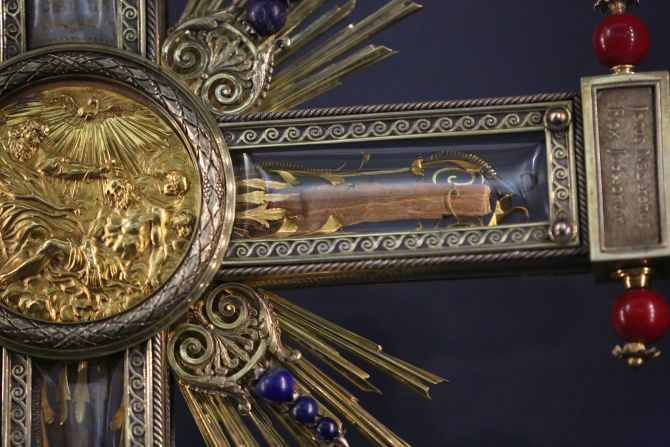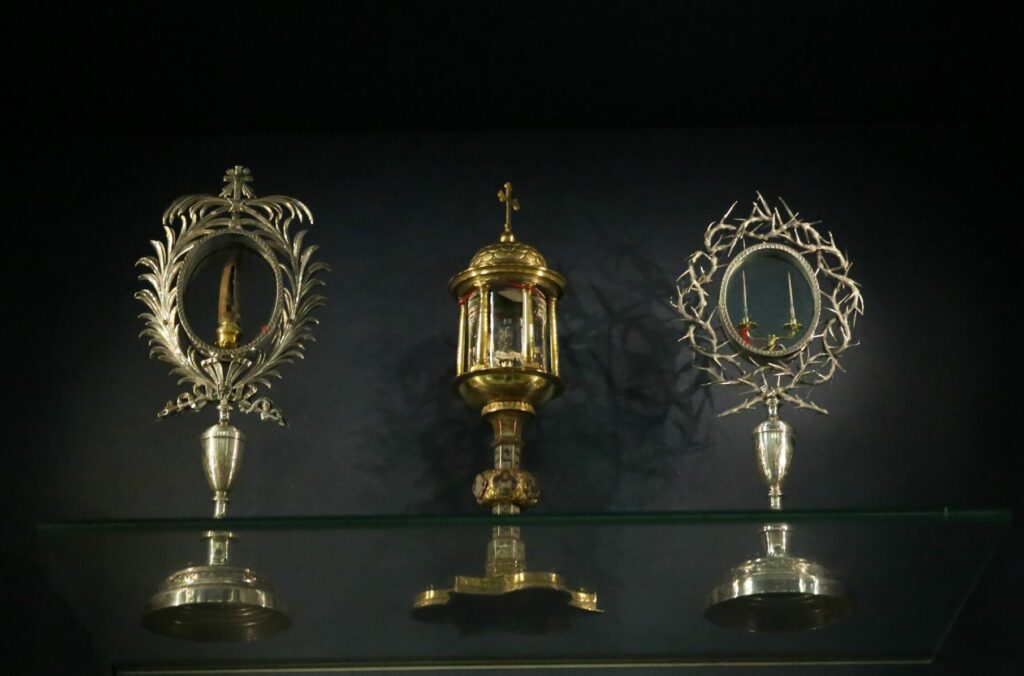“We adore Thee, O Christ, and we bless Thee because by Thy Holy Cross Thou hast redeemed the world.”
Do Catholics Worship the True Cross?
Throughout the entire year, but especially during the season of Lent, we are encouraged to pray the Stations of the Cross and obtain indulgences for doing so. Likewise, on Good Friday as part of the Liturgy of the Presanctified,[1] the priest and the faithful venerate the cross in what the missal refers to as the “Adoration of the Cross.”
Some may therefore ask, what degree of worship do we pay to the Cross? Is it latria or dulia? Fr. Broom explains the distinction, which illustrates why it matters:
“The theologians classify the greatness of those in glory with the following titles: ‘Latria’, which means adoration that we give to the Blessed Trinity, Father, Son and Holy Spirit. ‘Hyperdulia’ given to the Blessed Virgin Mary means the highest veneration. ‘Dulia’, given to the saints, implies veneration. Finally, Glorious Saint Joseph is rightly given ‘Protodulia’, meaning that among the saints he is given first place; ‘Proto’ means first!”
Thus, to ask if we worship the Cross with the honor and respect of God in the Blessed Sacrament or venerate it with the honor of the relics of the saints is an important one. It will therefore affect how we act in the presence of a relic of the true Cross. See “A Catholic Guide to Relics: What Kinds Are There and Why Do We Honor Them” for more on the basics of relics and why it is important that we honor them.
The Worship Owed to the True Cross Is Latria
Father Ryan Erlenbush took up the question back in 2011 and writes
“The theologians debate as to whether we truly worship and adore the Cross with the adoration of latria – the Thomists, following the best of both reason and faith, maintain that we do in fact worship the Cross with latria; but others (tending toward a literalist reading of certain texts from the early Church) hold that we do not worship the Cross but only give it veneration.
“The Church herself speaks quite boldly when she declares in the Sacred Liturgy that the Cross of Christ is our only hope (O Crux, ave, Spes unica!) and directs us to worship the Cross (Ecce lignum Crucis … Venite, adoremus).”
Father Erlenbush continues by appealing to the authority of St. Thomas Aquinas:
“St. Thomas affirms that worship is due, in the first place, to God alone – i.e., we worship only the Divine Essence (The Most Blessed Trinity) for its own sake. However, the Common Doctor rightly asserts that we worship also the flesh of Christ our Savior, not because the flesh is itself divine, but because this sacred flesh has been hypostatically united to the Divine Essence through the Person of the Word. In this respect it is clear that we worship with latria what is joined and united to the divinity in the work of our salvation.
“But the Cross was most highly and perfectly united to the Person of Jesus in the plan of salvation – for it was through the wood of the Cross that our Savior redeemed us. Moreover, this wood has been saturated with the most precious and holy Blood of our Lord. This same wood has borne the limbs of Christ and was sanctified by contact with his Body.”
Thus, the Church through the Angelic Doctor affirms that we do indeed worship the True Cross since the Cross is inseparably covered with the blood of the Second Person of the Most Blessed Trinity and the very means of His sacrifice. (The interested reader can read St. Thomas’ own words on the subject matter in the Summa Theologicae, Third Part, Question 25, Article 4.)

On a similar note, St. Louis de Montfort explains that latria offered to the Holy Cross is offered to Our Lord (and His Precious Blood) because the Holy Cross is inseparable from Our Savior Jesus Christ (and His Precious Blood).
The Veneration of the Faithful to the True Cross
Father notes the implication this has for the faithful:
“The True Cross of our Savior Jesus Christ is the greatest and most precious of all relics. It is only to the True Cross, from among all other relics, that the Christian faithful are instructed to genuflect. Every other image and relic (whether of our Lord or of any of the saints) is venerated by a bow, but the relic of the True Cross is adored and worshiped with a genuflection!”
The Irish Ecclesiastical Record (a monthly journal) from 1916 further notes the modifications legislated for the celebration of Mass if there is present a relic of the True Cross:
“If Mass is celebrated at any altar on which a relic of the True Cross is exposed, the celebrant is to genuflect when arriving at and departing from the altar and also when passing before the relic during the Mass.”
In a further distinction from other relics, when incensed, the True Cross is incensed three times and not twice, as done for other relics. And a priest who exposes the relic for veneration is instructed to vest in surplice and a red stole, except on Good Friday.
It should be noted that these acts refer exclusively to relics of the True Cross which are part of the actual Cross on which the Redeemer, Who is both God and man, died. In contrast, we should venerate any crucifixes and honor them, but those crosses are not to be adored in the same way as relics of the True Cross. Like any images of saints, images of Our Lord on the Cross are means for us to worship and adore Him. But they – unlike the Cross which is stained with His Blood – are not owed the worship of latria. Hence, the cross we venerate as part of the Liturgy on Good Friday is not worshipped with latria but with the veneration due to it representing Our Lord.
As mentioned in “A Catholic Guide to Relics: What Kinds Are There and Why Do We Honor Them,” there is also a pious belief that when Our Lord comes at the end of the world, all the pieces of the True Cross will be reunited and all men shall behold the Instrument of Our Salvation. Angels will accompany Our Lord and bear all the instruments of His Passion, which are our greatest relics – including the Crown of Thorns, the Nails, and the Lance that pierced His side.[2] We know for certain that at least one man-made object – the Holy Cross – will remain in Heaven for eternity even after this world is consumed by fire and God creates a New Heaven and a New Earth.

This is amazing! Sooner or later everyone will have to meditate upon the Passion. This is how the world ends, so important the Passion is! Calvary is the greatest display of God’s power in vanquishing evil! In hoc signo vinces. The Passion is at the center of the universe; it is at the center of history. This is precisely why God has chosen to re-present this Mystery in every Holy Mass!
Conclusion
This Lent, and always, let us worship the One, True God, venerate properly His Most Blessed Mother, honor the saints, and adore the price of our salvation, which is the wood of the Cross. We should likewise be prepared to genuflect to relics of the True Cross and should share this fact with other Catholics who likely were never taught of this distinction.
ENDNOTES:
[1] The term was used before the changes to Holy Week in 1955. After 1955, the Liturgy on Good Friday became known as the “Solemn Liturgical Action” of Good Friday. This is not a Mass since no consecration takes place. No Masses are permitted on Good Friday as part of the Roman Rite of the Catholic Church.
[2] From a sermon on the Second Sunday of Lent, by Fr. Martin Von Cochem (+1712): “At the end of time, Our Lord tells us His Cross will appear in the sky. Listen to one author describe this amazing reality. ‘All the Fathers concur in interpreting this sign which will be displayed in the Heavens as the Cross of Christ. Although the Cross whereon Our Lord suffered is now divided into innumerable little pieces, into particles even, yet by Divine power it will once more form a complete whole. [not a sliver shall be lost]. It will be carried down from Heaven by the Angels with solemn pomp; and the Angels who bear It will be followed by others, who, as the Angelic Doctor St. Thomas Aquinas maintains, will carry all the other instruments of the Passion; that is to say, the pillar, the lance, the scourges, the hammer, the iron glove, the dice, the scarlet robe, the white robe, the seamless tunic, the holy winding sheet, the vessel containing myrrh and all the other instruments that were employed during the Passion, and the object of this will be to make manifest to the whole world how many and manifold were the pains Christ suffered for our sakes… His whole Passion will seem to be re-enacted before them.’”




